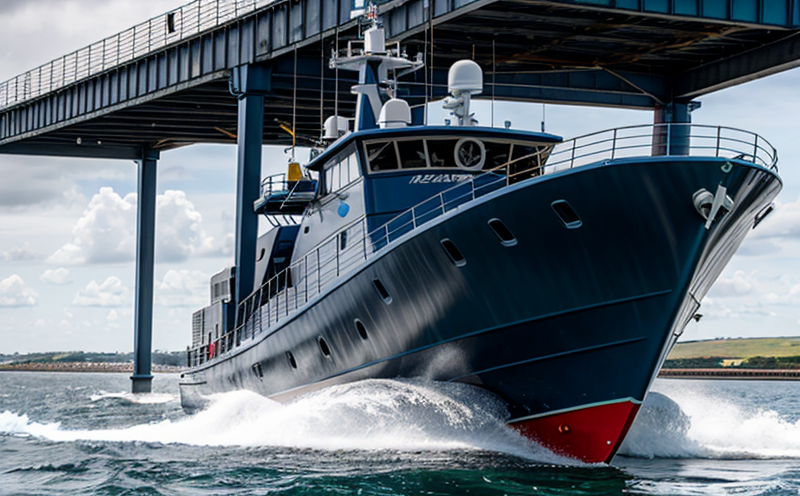ISO 484 Propeller Geometry and Accuracy Testing
The ISO 484 standard is a cornerstone in ensuring that marine propellers meet the highest standards of geometry and accuracy, which are critical for performance, efficiency, and safety. This service focuses on the detailed testing and validation processes required to ensure compliance with this international standard.
Marine engines and propulsion systems are complex assemblies where even small deviations from ideal geometry can lead to significant operational inefficiencies or risks. In the context of marine applications, propellers must be precisely manufactured to ensure optimal performance under various operating conditions. This includes maintaining a consistent blade angle, pitch distribution, and surface finish that influence fuel consumption, thrust generation, noise levels, and overall vessel stability.
The ISO 484 standard sets stringent requirements for the measurement of propeller geometry and accuracy. It specifies not only the parameters to be measured but also the permissible tolerances within which these parameters must fall. Compliance with this standard is crucial for ensuring that a marine propeller performs as designed, thereby enhancing vessel efficiency and safety.
Our testing service aligns closely with ISO 484, providing comprehensive analysis of propeller geometry through advanced instrumentation and measurement techniques. We use state-of-the-art equipment to ensure precise measurements and accurate data collection. Our team of experts ensures that every aspect of the propeller is evaluated meticulously, from its blade angles to surface finish.
The testing process begins with thorough preparation of the propeller specimen. This involves cleaning the propeller to remove any foreign materials or residues that could affect measurement accuracy. The propeller is then carefully positioned on our testing rigs, which are designed specifically for this purpose. Once in position, we measure key parameters such as blade angle, pitch, and chord length with high precision.
After initial measurements, the propeller undergoes detailed analysis to assess its overall geometry. This includes not only linear dimensions but also more complex parameters like camber and twist distribution. Our software allows us to generate three-dimensional models of the propeller, enabling a deeper understanding of any deviations from the ideal form.
The testing process concludes with the generation of a comprehensive report detailing all measurements and comparisons against ISO 484 standards. This report serves as a valuable resource for quality managers, compliance officers, R&D engineers, and procurement teams to ensure that their marine propellers meet the highest industry standards.
Scope and Methodology
| Parameter | Description |
|---|---|
| Blade Angle | The angle between a blade's chord line and the plane of rotation. |
| Pitch Distribution | A measure of how much thrust is generated at different points along the propeller blade. |
| Camber | The curvature of each blade's surface from leading edge to trailing edge. |
| Twist Distribution | The change in angle between adjacent blades or sections of a blade. |
The methodology for ISO 484 propeller geometry and accuracy testing involves the use of advanced measurement tools such as laser scanners, coordinate measuring machines (CMMs), and specialized software. These tools are employed to ensure precise and repeatable measurements that adhere strictly to the criteria outlined in the standard.
Industry Applications
| Application Area | Description |
|---|---|
| Vessel Performance Optimization | Better propeller geometry can lead to increased fuel efficiency and reduced emissions. |
| Safety Enhancement | Compliant propellers reduce the risk of mechanical failures, contributing to safer operations. |
| Eco-Friendly Operations | Efficient propellers contribute to lower carbon footprints by optimizing energy use. |
| R&D and Innovation | Testing ensures that new designs meet rigorous standards before implementation. |
In the marine industry, ISO 484 compliance is essential for vessel operators looking to enhance their operational efficiency while adhering to regulatory requirements. By ensuring that propellers are manufactured and tested according to these stringent international standards, we contribute to safer, more environmentally friendly operations.
Environmental and Sustainability Contributions
- Reduces fuel consumption through optimized geometry.
- Promotes reduced emissions by enhancing operational efficiency.
- Contributes to quieter vessel operations, which can reduce noise pollution in marine environments.
- Fosters sustainable development by supporting the production of high-performance, low-impact propellers.
The ISO 484 testing service plays a pivotal role in promoting sustainability and environmental responsibility within the maritime industry. By adhering to these standards, ship operators can make significant strides towards greener operations without compromising performance or safety.





